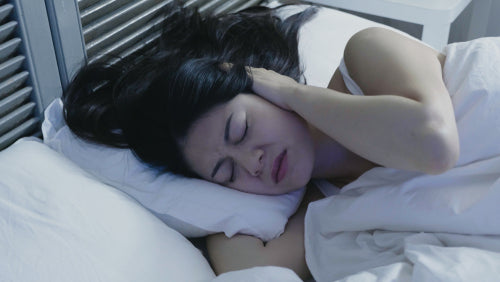What Are Night Terrors?

Your child screams from her bedroom in the middle of the night and you come running. She flails and thrashes, sweats, has an increased heart rate, and looks absolutely terrified. Her eyes are open, but she doesn’t seem to see or recognize you. You may feel as scared as she looks, or feel helpless in the face of the fear she’s so obviously feeling.
Then, a few seconds or a few minutes later, she is suddenly calm. She falls asleep again on her own, and you straggle back to bed feeling spent and confused.
What’s going on?
Night Terrors
Children who have night terrors like these may appear absolutely terrified, but they’re not really dreaming—nor are they really awake. Night terrors sometimes occur in young children as they transition from deep REM sleep (where dreams occur) to light REM sleep (where there are no visual or experiential dreams).
According to KidsHealth, night terrors are basically caused by overstimulation in the central nervous system (CNS) during sleep—perhaps after a dream, perhaps in response to the pressure of a full bladder during a deep phase of sleep. In any case, the hyper-stimulated CNS releases a rush of adrenaline that triggers an automatic flight response. Your child is showing all the signs of terror, but she’s not reacting to the mental imagery of a dream and is too deeply asleep to interact with the waking world.
When Do Night Terrors Occur?
Night terrors have been reported in boys and girls, usually between the ages of four and twelve years. They’ve been reported in children two years old or younger, though cases are fairly rare.
Most kids grow out of night terrors as the nervous system matures, though some adults suffer from night terrors. Night terrors may continue from childhood into adulthood or present for the first time in grown-ups, usually those who have suffered a traumatizing event or are struggling with some form of psychological difficulty. Night terrors in adults are associated with a higher instance of psychological disorder, so see a specialist if you’re concerned.
Night terrors in children are usually no cause for alarm. They are usually a side effect of a normal but immature nervous system that rights itself with age—not an indicator of psychological or emotional disturbance. Still, if they happen nightly or are severe enough that the child risks injury, seek the help of a pediatric therapist or sleep specialist.
How to Help a Child with Night Terrors
If your little one is having night terrors your first instinct will probably be to hug him or her in an attempt to calm the child. Remember, your child is still sleeping deeply and does not consciously see or hear you, so hugging or restraining him can just make matters worse.
Don’t try to wake a child having night terrors. Watch to minimize the chances of injury, let the child settle down on his own, and then tuck him in as he drifts back into deep sleep. If it truly was a night terror and not a bad dream, the child will have no memory of the event in the morning.
Since our brains and bodies don’t remember night terrors, there’s no danger of the episode doing lasting harm to your little one’s psyche or physiology (as long as injuries are prevented during the event). This one really is tougher on the parent than the child, but with patience and acceptance you can get through night terrors with minimal trouble.
Author Bio: +Michelle Gordon is a sleep expert who researches and writes about sleep and health, and is an online publisher for the latex mattress specialist Latexmattress.org.


